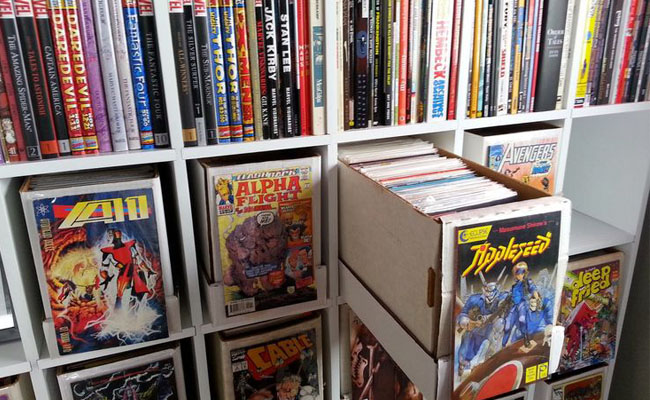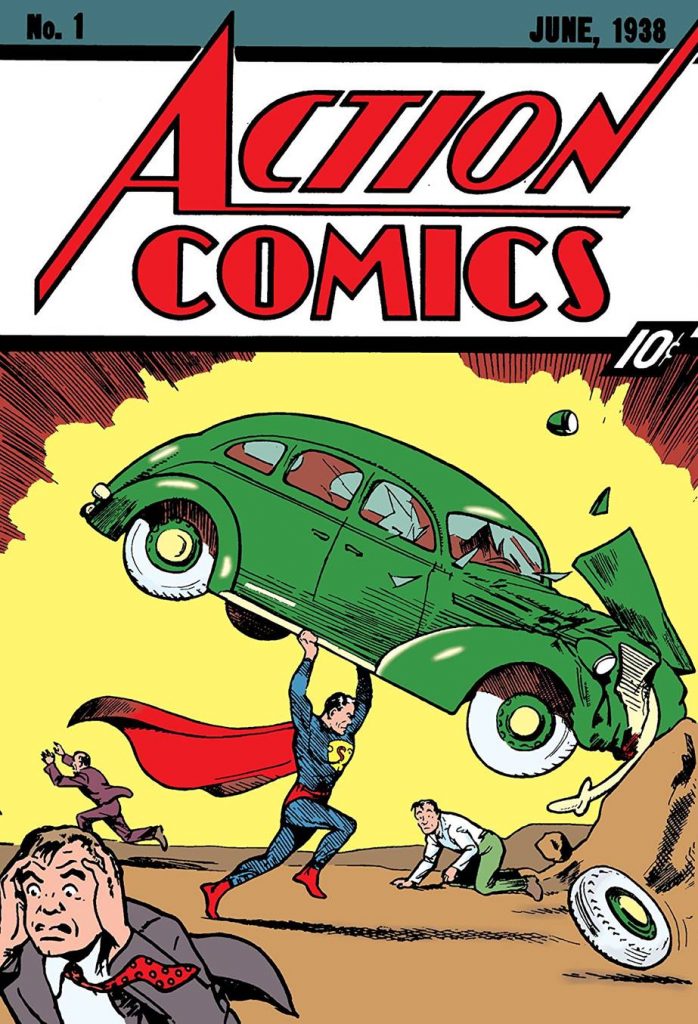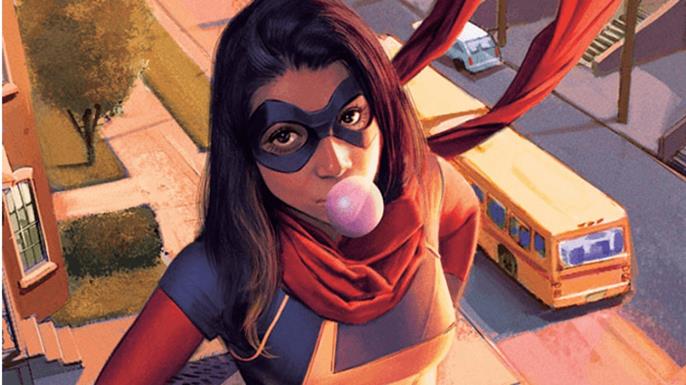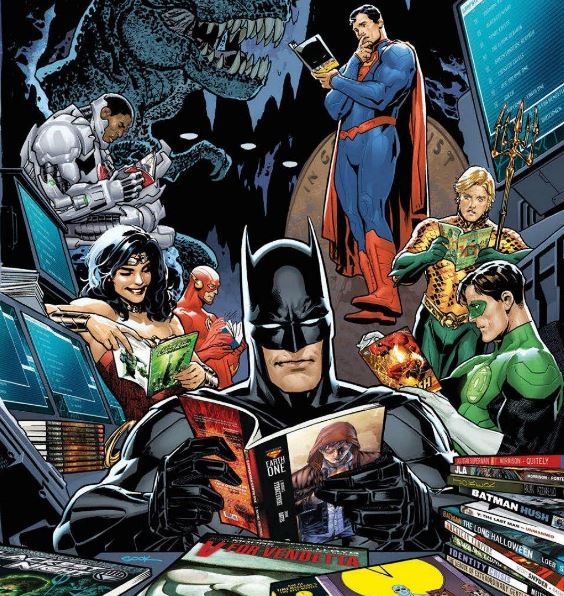September 25th is National Comic Book Day, which is as good a reason as any to check in on one of the greatest of all art forms. Yet, comics are also a uniquely intimidating art form if you’re not already steeped in them – what should you read? In what order should you read it? Can you find comics based on the cool movie you saw? Here’s five big things to know about comics if you’re looking to get started:
1. Comics, Graphic Novels, and Trade Paperbacks
Comics, graphic novels, and trade paperbacks all share common characteristics – they convey stories through a combination of words and sequential art – but they are not the same thing. While the three terms can often be used interchangeably, from a publishing standpoint they are different things and are sold, marketed, and tracked differently. Think about it in terms of television:
Comics or comic books usually refer to the periodical pamphlet-style books that hit shelves on a set schedule – generally monthly, though some books may be bimonthly or even weekly as part of a special event. Also referred to as “issues” or “floppies”, these are often serialized parts of a larger story. If you wanted to read the current Miles Morales: Spider-Man story as it comes out – not unlike keeping up with a TV show week-to-week – you could go to your comics distributor of choice and subscribe to it so you get a new issue every time it’s released (more on this later). An individual issue of a comic book can cost between $3-$5 for around 20-22 pages with ads, but special event issues may cost even more (the recent Marvel Comics #1000 event to celebrate that company’s 80th anniversary cost $10 but weighed in at over 90 pages with higher-quality paper, square binding and fewer ads).

For those willing to wait a few months for the latest updates in their favorite adventures, trade paperbacks or collections are an option. Despite the name, trade paperbacks can sometimes come in hardcover as well. A trade paperback contains a set number of single issues, usually 5-6, that constitute a single story arc (not unlike buying a season of your favorite TV show on disc or binging on Netflix). Occasionally, a trade paperback may also include ancillary material like scripts, variant covers, or concept art; some may also include extra standalone comics that are not part of the main arc but aren’t collected elsewhere. If you are looking to get into the ongoing story of a particular series or character, “trades” offer an easy and inexpensive way to do so – most trades are cheaper than buying the individual issues of a story and are kept in print longer so they’re easier to find. For waiting, you also get better-quality covers and paper, though the expense is you’re sometimes half a year or more behind on the latest plot developments.
Unfortunately, it’s here where we enter the realm of nit-picking, as many readers refer to trades as graphic novels. In fact, a graphic novel should be considered material that is created exclusively for inclusion in a long-form standalone format – generally, it is not collected or reprinted from other sources like a trade. While graphic novels can be fictional or non-fictional in nature, the one thing they consistently are is self-contained (i.e. if you buy the book, you get the whole story). Books like Marjane Satrapi’s Persepolis, Art Spiegelman’s Maus, or even Dav Pilkey’s Dog Man series are comics created in this way. There may be an element of serialization in some graphic novels (Persepolis is two books, Dog Man is an ongoing series), though.
There are of course books that straddle the line between these categories – Watchmen, for example, was originally published as a 12-issue series but has more or less exclusively been available in graphic novel format since its initial release (and arguably reads better that way due to its complex intertextual references and ancillary materials). Ultimately, read what interests you – but if you’re just starting out, find some graphic novels or trade paperbacks that relate to a character, story, or genre you’re interested in. Some trades even come in omnibus format, collecting an entire series or multiple trades in one massive volume.
2. It’s Not Just Superheroes

The cape-and-spandex crowd are a lot of fun, but for many reasons they aren’t for everyone. Luckily, comics are an incredibly versatile medium. Whether you’re interested in fantasy, non-fiction, history, Westerns, war stories, or anything else, you can find comics for you. Here are just a few popular and easy-to-find recommendations with nary a cowl to be found:
- Saga. This bizarre epic fantasy is decidedly for open-minded adults (and I cannot stress that enough, this comic is not appropriate for kids, do not give it to kids unless you are prepared to answer some questions) but uses its outlandish concepts and strange alien creatures to tell a universal and often heart-breaking story of forbidden love, the difficulties of parenthood, and the harsh and arbitrary nature of war. Reading this comic month-to-month is emotionally exhausting and maybe easier to handle in trade, but the jaw-dropping splash panels that end each issue give you something to chew on. Currently on a lengthy hiatus, but collections and omnibus editions make it easy to catch up.
- Transmetropolitan. If you dropped Hunter S. Thompson in the dystopian techno-futures of William Gibson, you’d basically get Warren Ellis’ sci-fi masterpiece. Equal parts funny, thought-provoking, disturbing, and even heartbreaking, this story follows gonzo journalist and infamous curmudgeon Spider Jerusalem as he uses the power of the press to battle against corruption and inequality. Again, not for kids, but the weighty sci-fi concepts are a lot of fun, and despite its grimy cynicism it’s ultimately a kind-hearted, humanist work.
- Sandman. Fans of Neil Gaiman’s fantasy work owe it to themselves to read what is arguably his masterwork, a long-running series exploring the nature of stories and reality through the eyes of Morpheus, the embodiment of dreams*. The art is beautiful, the stories are challenging, and once you’ve completed the main series you can delve into some of the spinoffs and standalone stories. Bonus: a few DC Comics mainstays pop in from time to time!
3. Comics Are Fun to Collect, But They Aren’t Your Retirement Plan
Every so often, headlines of outlandish prices for vintage comics surface. Last year, a copy of Action Comics #1 sold for over two million dollars at auction – and that was only the third-highest sum ever fetched (https://icv2.com/articles/news/view/39875/high-graded-amazing-fantasy-15-sold-auction-record-sum). Copies of Amazing Fantasy #15, the first appearance of Spider-Man, regularly sell for hundreds of thousands of dollars (https://icv2.com/articles/news/view/39875/high-graded-amazing-fantasy-15-sold-auction-record-sum). It’s enough to make anyone scour the attic of their childhood home or scrounge through yard sales looking for a big payday. The reality, though, is that the comics market is like anything else – they’re only worth what people are willing to pay, and the market is largely defined by speculators who snap up comics in the hopes they’ll be worth something someday. Take, for example, 1992’s The Death of Superman event, in which the legendary hero met his apparent demise at the hands of the unstoppable monster Doomsday. The momentous event generated massive demand as prospective millionaires snapped up as many issues as they could, leading to sell-outs and long lines at local comic shops. The issue became one of the best-selling comics of all time, but because of the massive amounts of copies in the wild and the fact Superman was revived at the end of the story, demand on the secondary market is minimal – there are now stacks of unopened Death of Superman issues collecting dust in quarter bins around the country.

A good rule of thumb is that most comics aren’t going to climb in value – the most valuable comics are valuable because they have significant cultural relevance and (more importantly) are scarce in even passable condition. Nevertheless, there are some common themes to look out for. First issues of popular series are often valuable – a first-print issue #1 of Saga, for example, can range from $100-$400 depending on condition. Second, books that are the first appearance of a major character are valuable – especially if a major movie starring that character is released. An excellent condition Edge of Spider-Verse #2, the first appearance of Gwen Stacy as Spider-Woman (aka Spider-Gwen), could potentially fetch between $300-500 thanks to her feature role in the Into the Spider-Verse film. Third, condition matters – and doubly so if the book is verified and graded by the CGC company, which assigns a number grade to a given book based on how close to “perfect condition” it is. The higher the number, the better condition the book is in and the more valuable it is – though submitting your books can be pricey (https://www.cgccomics.com/submit/services-fees/cgc/).
I personally recommend collecting comics because you enjoy and are inspired by them, or you want to have something to share with the people you love. If you want to protect their value as best you can or save them for future readers, invest in cardboard “longboxes” designed to store the books upright, and put them in mylar bags with cardboard backing sheets (all helpfully available at your local comic shop). You could also give them away to local kids’ charities, use them in art projects, or just read them again and again. They’re fun, enjoy them! But don’t rely on them to put little Kal-El through college.
4. Comics Continuity Can Confound Careless Consumers
A quick note for those of you looking to continue the adventures of your favorite costumed heroes on the page – be prepared to do a little bit of research. The superhero industry is notoriously bad at onboarding new readers, due in no small part to the fact that they have to often balance the need of protecting decades of continuity for long-term fans and the need to attract new readers who don’t have time to delve through those same decades of lore.
For example, in 2005 DC launched the Infinite Crisis storyline, which saw a massive conspiracy targeting the planet’s superheroes. The first issue culminates in Maxwell Lord, the head of the Checkmate spy agency, murdering the hero Blue Beetle – a reveal completely robbed of its impact if you hadn’t read the then-nearly 25 year-old Justice League series where Lord served as the shifty benefactor of the Justice League team of which Beetle was a part. I remember being puzzled as a relatively recent DC fan – it wasn’t until I did more research later that I realized the moment’s significance.
More recently, the controversial Secret Empire storyline saw Captain America replaced by an evil alternate version manipulated by Nazi deep science organization Hydra who subjugated the world under his rule until the real Captain America did battle with the evil one after emerging from the Cosmic Cube, an artifact of incredible power originating in the 1960s Captain America comics and you’re already drifting off aren’t you? That’s a lot of legwork for folks interested in checking out what Ta-Nehisi Coates is doing with Captain America in his current series, and it’s emblematic of an ongoing issue with superhero comics.

Worse yet? I don’t have a good answer here. Even “relaunches” of superhero comics aimed at being jumping-on points for new readers often regress back to the old continuity after a while. If you’re a fan of the movies inspired by these comics, you may often find completely different characterizations and stories than you expect – which can be frustrating. The best advice? Ask an expert. Which leads us to the final point:
5. Comics are Nearby and Easy to Get
Luckily, you’re spoiled for choice when it comes to acquiring the books. There are three main options. The first and arguably best option is your local comic shop. The folks running these establishments generally know their stuff, have a great selection of books new and old, and can offer recommendations of where you should start. If you like a series, you can request that new issues are “pulled” every month and set aside for you – your shop may even offer a discount for this. They also often have a ton of other collectibles, and you can feel good about supporting a local business. Once a year, they also host a special event called Free Comic Book Day, where you can pick up special free comics from various publishers and licenses – Marvel and DC often use this event to launch new stories. Second, you can also hit up your local library – most have an ample collection of comics and graphic novels and knowledgeable librarians who can help you find what you’re looking for. Some, like the Brown County Library, even host special Comic-Con events with appearances by artists and writers.

If you’re not in the mood to leave your house, most comics are available digitally the same day as their print release through Comixology and other online platforms. Comixology also offers a monthly subscription plan that offers both exclusive catalog titles and new releases as well as special discounts – some local shops even have special storefronts through the service, so ask around if you want to get your comics digitally and still support local businesses. Speaking of special subscriptions, both DC and Marvel offer extensive access to their archives through their Universe and Unlimited platforms, respectively. There’s a six-month delay on new titles for Marvel Unlimited and a year or so delay on new titles for DC Universe, but if you’re looking for sheer scope and to really seriously dig into the back catalog, both are recommended – DC Universe also gives you access to select DC movies, TV shows, and original series created for the platform (I recommend Doom Patrol).
No matter what you’re reading or how you read it, the most important thing to know about comics is that they’re meant to be enjoyed. Read what you want, when you want, and how you want – and don’t let anyone else dictate what you should do. Looking for more suggestions? Leave your questions in the comments below.
*If you are considering writing to correct me, I am aware that he is actually Dream, one of the Endless, but this is easier for now.

By Dr. Bryan Carr
Bryan Carr is an Associate Professor in the Communication, Information Science, and Women’s & Gender Studies departments. Among other things, he is the host and producer of “Serious Fun”, a podcast taking an academic look at popular culture on the Phoenix Studios podcast network.

I liked it when you shared that it is great to collect comic books that you enjoy reading and are inspired by them. My friend just mentioned the other day that she is planning to look for any reading materials for her son who has been playing video games all day long. I will suggest to her getting comic books that suit his interest from a reliable store.
I like that you talked about being able to continue reading about your favorite characters when you have their comics. I would love to find a Woodstock horror comic book for sale since it has been my interest for the past year. It would be a good way to spend my free time during the weekends since I rather stay at home than go out most of the time.